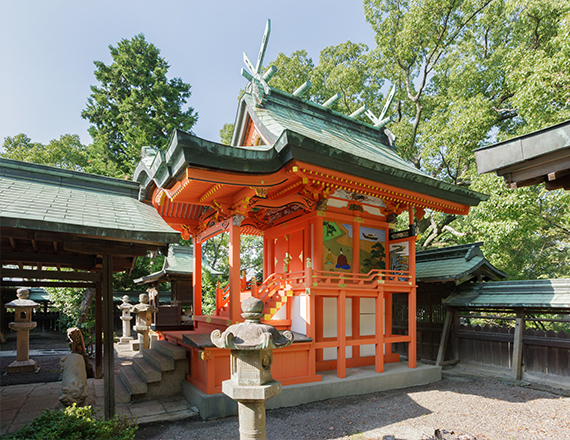Aritoshi Jinja Shrine
Labeled “Anatoshi Jinja Shrine" on two paintings depicting the local area, this shrine is the head shrine of Nagataki Village. The shrine’s history includes connections to the Kumano-mode pilgrimage and Heian Period poet Ki no Tsurayuki. Noh has been performed in its Maidono pavilion since ancient times and is still performed there today.

Although the date of its foundation is unknown, according to its own history, it was founded to enshrine deities under the reign of Emperor Kaika, the ninth emperor. It was referred to as “Aritoshi Jinja Shrine” in “Izuminokuni Jinmyocho” in 1289 and was depicted as “Anatoshisha” in two paintings of the shoen. The name of the shrine apparently came from a legend about “a lieutenant general who harbored his aged parents in the capital against the emperor’s order, was allowed to live with them since he succeeded in threading cylindrical beads (according to one theory) using an ant thanks to the wisdom of his aged father, and later was worshipped at the shrine as a deity,” which can be found in “Makura no Soshi” (The Pillow Book). On the other hand, there is also a theory that it is based on the phrase “ari no kumano-mode” (a pilgrimage of ants to the Kumano-sanzan, the three grand shrines of Kumano) that is associated with the Kumano faith due to its location along the Kumano Kaido road.
According to “Kino Tsurayuki-shu” (Kino Tsurayuki anthology), Tsurayuki’s horse fell ill on his way back from Kiinokuni (Kii Province, now Wakayama Prefecture and the southern part of Mie Prefecture), and a passer-by advised Tsurayuki to pray to “Aritoshi no kami.” Following this advice, Tsurayuki dedicated a poem to the deity: “かき曇りあやめもしらぬ大空にありとほしをは思ふへしやは (Suddenly the sky has become overcast. It’s pitch-dark night this night … so, who could have ever guessed that stars would shine in the sky? Nobody could. Neither could I.)”* The horse recovered from its illness. Based on this historical event, the yokyoku (Noh song) “Aridoshi” was composed by Zeami in the Muromachi Period. Based on this legend, Noh is still performed with the precincts of the shrine.
The inner shrine is built in the Ikkensha Kumakiiri kasuga-zukuri style with kara hafu (cusped gables) at the front. It is thought that the stage within the shrine’s precincts was built when the shrine was repaired by Okabe Nagayasu, a feudal chief of the Kishiwada Domain in 1669, and it features a rare architectural style in this region. It was originally located along the Kumano Kaido but was moved to its current location following the construction of the Akeno Army Aviation School Sano Air Field during the Pacific War.
*This poem features a play on the words ありとほし (aritohoshi), which means there are stars, and ありとしのかみ (aritoshi-no-kami), which means gracious deity.






